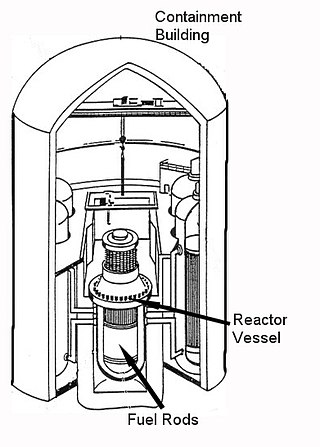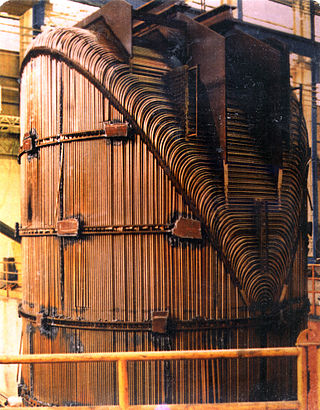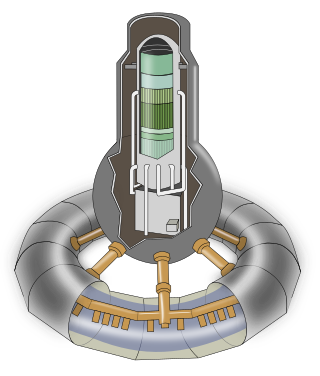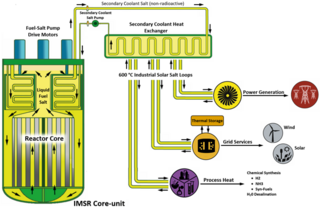
A boiling water reactor (BWR) is a type of light water nuclear reactor used for the generation of electrical power. It is the second most common type of electricity-generating nuclear reactor after the pressurized water reactor (PWR), which is also a type of light water nuclear reactor.

The RBMK is a class of graphite-moderated nuclear power reactor designed and built by the Soviet Union. The name refers to its design where, instead of a large steel pressure vessel surrounding the entire core, the core is surrounded by a cylindrical annular steel tank inside a concrete vault and each fuel assembly is enclosed in an individual 8 cm (inner) diameter pipe. The channels also contain the coolant, and are surrounded by graphite.

The light-water reactor (LWR) is a type of thermal-neutron reactor that uses normal water, as opposed to heavy water, as both its coolant and neutron moderator; furthermore a solid form of fissile elements is used as fuel. Thermal-neutron reactors are the most common type of nuclear reactor, and light-water reactors are the most common type of thermal-neutron reactor.

BWX Technologies, Inc., headquartered in Lynchburg, Virginia is a supplier of nuclear components and fuel to the U.S.

Babcock & Wilcox is an American energy technology and service provider that is active and has operations in many international markets across the globe with its headquarters in Akron, Ohio, USA. Historically, the company is best known for their steam boilers.

A containment building is a reinforced steel, concrete or lead structure enclosing a nuclear reactor. It is designed, in any emergency, to contain the escape of radioactive steam or gas to a maximum pressure in the range of 275 to 550 kPa. The containment is the fourth and final barrier to radioactive release, the first being the fuel ceramic itself, the second being the metal fuel cladding tubes, the third being the reactor vessel and coolant system.
The Advanced CANDU reactor (ACR), or ACR-1000, was a proposed Generation III+ nuclear reactor design, developed by Atomic Energy of Canada Limited (AECL). It combined features of the existing CANDU pressurised heavy water reactors (PHWR) with features of light-water cooled pressurized water reactors (PWR). From CANDU, it took the heavy water moderator, which gave the design an improved neutron economy that allowed it to burn a variety of fuels. It replaced the heavy water cooling loop with one containing conventional light water, reducing costs. The name refers to its design power in the 1,000 MWe class, with the baseline around 1,200 MWe.

The supercritical water reactor (SCWR) is a concept Generation IV reactor, designed as a light water reactor (LWR) that operates at supercritical pressure. The term critical in this context refers to the critical point of water, and must not be confused with the concept of criticality of the nuclear reactor.

A sodium-cooled fast reactor is a fast neutron reactor cooled by liquid sodium.

A steam generator is a heat exchanger used to convert water into steam from heat produced in a nuclear reactor core. They are used in pressurized water reactor between the primary and secondary coolant loops.

The water-water energetic reactor (WWER), or VVER is a series of pressurized water reactor designs originally developed in the Soviet Union, and now Russia, by OKB Gidropress. The idea of such a reactor was proposed at the Kurchatov Institute by Savely Moiseevich Feinberg. VVER were originally developed before the 1970s, and have been continually updated. As a result, the name VVER is associated with a wide variety of reactor designs spanning from generation I reactors to modern generation III+ reactor designs. Power output ranges from 70 to 1300 MWe, with designs of up to 1700 MWe in development. The first prototype VVER-210 was built at the Novovoronezh Nuclear Power Plant.

The Economic Simplified Boiling Water Reactor (ESBWR) is a passively safe generation III+ reactor design derived from its predecessor, the Simplified Boiling Water Reactor (SBWR) and from the Advanced Boiling Water Reactor (ABWR). All are designs by GE Hitachi Nuclear Energy (GEH), and are based on previous Boiling Water Reactor designs.

The BN-600 reactor is a sodium-cooled fast breeder reactor, built at the Beloyarsk Nuclear Power Station, in Zarechny, Sverdlovsk Oblast, Russia. It has a 600 MWe gross capacity and a 560 MWe net capacity, dispatched o the Middle Urals power grid. It has been in operation since 1980 and represents an evolution on the preceding BN-350 reactor. In 2014, its larger sister reactor, the BN-800 reactor began operation.
The three primary objectives of nuclear reactor safety systems as defined by the U.S. Nuclear Regulatory Commission are to shut down the reactor, maintain it in a shutdown condition and prevent the release of radioactive material.

Small modular reactors (SMRs) are a proposed class of nuclear fission reactors, smaller than conventional nuclear reactors, which can be built in one location, then shipped, commissioned, and operated at a separate site. The term SMR refers to the size, capacity and modular construction only, not to the reactor type and the nuclear process which is applied. Designs range from scaled down versions of existing designs to generation IV designs. Both thermal-neutron reactors and fast-neutron reactors have been proposed, along with molten salt and gas cooled reactor models.
The Energy Multiplier Module is a nuclear fission power reactor under development by General Atomics. It is a fast-neutron version of the Gas Turbine Modular Helium Reactor (GT-MHR) and is capable of converting spent nuclear fuel into electricity and industrial process heat.

General Electric's BWR product line of boiling water reactors represents the designs of a relatively large (~18%) percentage of the commercial fission reactors around the world.

The Integral Molten Salt Reactor (IMSR) is a nuclear power plant design targeted at developing a commercial product for the small modular reactor (SMR) market. It employs molten salt reactor technology which is being developed by the Canadian company Terrestrial Energy. It is based closely on the denatured molten salt reactor (DMSR), a reactor design from Oak Ridge National Laboratory. It also incorporates elements found in the SmAHTR, a later design from the same laboratory. The IMSR belongs to the DMSR class of molten salt reactors (MSR) and hence is a "burner" reactor that employs a liquid fuel rather than a conventional solid fuel; this liquid contains the nuclear fuel and also serves as primary coolant.
A nuclear microreactor is a plug-and-play type of nuclear reactor which can be easily assembled and transported by road, rail or air. Microreactors are 100 to 1,000 times smaller than conventional nuclear reactors, and when compared with small modular reactors (SMRs), their capacity is between 1 and 20 megawatts whereas SMRs comes in the range from 20 to 300 megawatts. Due to their size, they can be deployed to locations such as isolated military bases or communities affected by natural disasters. It can operate as part of the grid, independent of the grid, or as part of a small grid for electricity generation and heat treatment. They are designed to provide resilient, non-carbon emitting, and independent power in challenging environments. The nuclear fuel source for the majority of the designs is "High-Assay Low-Enriched Uranium", or HALEU.














